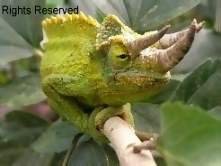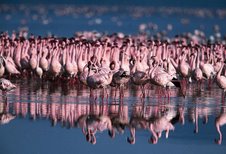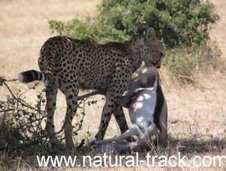Semliki National Park and the beautiful Semliki wildlife reserve lies
on the southern shores of Lake Albert and offers a mosaic of different
habitats with some excellent birding opportunities.
Perfectly situated in a remote corner of southwestern Uganda,
Semuliki National Park protects an eastern extension of the vast Ituri
Forest and forms part of a forest continuum that stretches across the
Democratic Republic of Congo to the Zaire River.
Semuliki National Park (220 km2) gazetted in October 1993, is one of
Uganda’s newest National Park. The Park occupies a flat to gently
undulating landform ranging from 670 -760 metres above level. As all
streams and rivers from the surrounding areas are flooded drain into the
Park plus the poor drainage and topography, many areas are flooded
during the rainy season. The average annual rainfall is 1250 mm with
peaks from March to May and September and December. The temperature
varies from 18o C – 30o C with relatively small daily variations.
Being a relatively stable forest “refugium” during the climatic
upheavals of the Pleistocene, this is one of the richest areas for
forest birds in Africa. A large number of predominantly Central African
species reach the eastern limit of their distribution here and cannot be
found anywhere else in East Africa. These include some of the
continent’s most spectacular and sought-after birds such as; Congo
Serpent Eagle, Long-tailed Hawk, Nkulengu Rail, Black-wattled Horn-bill
and Lyre-tailed Honey guide.
Although it lies a bumpy three hours’ drive from Fort Portal, birders
who take Uganda safaris, find Semuliki National Park to be richly
rewarding with some of the very best forest birding in Uganda.
Jungle life in Semuliki is breathtaking especially for birders,
primate, butterfly, and plant lovers. The jungle walk usually takes you
up to River Semuliki meanders, the only one of its kind in East Africa.
With luck, you may see forest buffaloes and elephants, sitatungas,
leopards, pigmy hippopotamus, crocodile primates and a wide range of
forest and water birds. You can also come with fishing facilities for
sport fishing along the river.
The Toro-Semuliki Wildlife Reserve (formerly called the Toro Game
Reserve) is subtly different and shows affinities with the northern
savanna woodland with over 400 birds species coupled with a number of
exotic scenery views
Fantastic scenery, Hot springs, forest jungle walk, birding, primate
viewing and river Semuliki meanders are some of the ideal attractions.
Surely, you don’t have to miss but get off the regular tourists’ circuit
and spend three to five days camping and hiking in this jungle part of
the world.
There are two Hot springs situated in a tract of hot mineral
encrusted swampland, rich in visible birds, insects and mammal life
accessible by modern trail network. Come and see a two meters jet of hot
water (130oC) and a pool (12 m diameter) of oozing boiling water
(106oC). You can boil food especially eggs in the natural boiler within
ten minutes and enjoy it.
Did you know that a trip to Semuliki has the most marvel and
breathtaking views? Come and experience the most thrilling meandering
Bundibugyo road through the Rwenzori escarpments. At ‘Mungu Ni Mukubwa’
while in the mountains, the road offers scenic views of the meandering
Semuliki River, fuming Hot springs and the tropical rain forest
extending up to Ituri forest in DRC.
Semuliki National Park lies along the main fort Portal to Bundibugyo
road, 52 km from Fort Portal. The road can become treacherous,
particularly after heavy rains, requiring a 4 WD or a sturdy 2WD with
sufficient clearance. The ranger post at Sempaya is well signposted but
the park headquarters have been moved to the village of Ntandi, a
further 4.4 km along the road to Bundibugyo. The usual National Park
fees apply.
From Sempaya it is 10.6 km to the village of Kirumia and start of the
Kirumia River trail into the forest. It is possible to hitch a ride
between Sempaya and Kirumia but bear in mind that most vehicles head
towards Fort Portal in the mornings; traffic in the direction of
Bundibugyo passes mainly in the late afternoon and evening.
Experience Semliki national park, a stepping stone to Central Africa, unforgettable views.
PKP. safaris kenya desk
Subscribe to:
Post Comments (Atom)









No comments:
Post a Comment